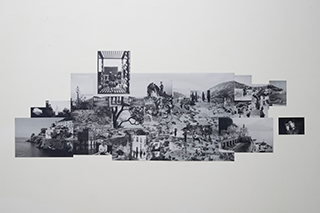
Leone Contini, Italienische Reise 2021-2022
stampa digitale su carta | digital print on paper
Quest’opera ha ricevuto il sostegno del Goethe-Institut di Napoli | This work received the support from the Goethe-Institut Naples
Commissionato per Bellezza e Terrore: luoghi di colonialismo e fascismo | Commissioned for Beauty and Terror: sites of colonialism and fascism
Courtesy dell’artista | Courtesy of the artist
Photo © Amedeo Benestante
The images shot in Campania from 1942 to 1943 by Wehrmacht soldier Hillmar Landwehr, are like holiday snaps, and hardly contain any explicit references to the ongoing war. Moreover, these have been taken before the armistice and Italians and Germans are still allies. The soldier is a kind of 1950s ante litteram tourist, the war remains in the background, invisible. We do not know the motivations of Landwehr’s journey between Rome and Sicily, via the Amalfi Coast, and perhaps that is not the main interest. What I find interesting is his gaze, and his (re)construction of an iconography of the landscape that is familiar to us: women standing by the fountain, a farmer on a donkey, ruins overlooking the sea, terraced hills, fishermen, the exuberance of the Mediterranean flora, prickly pears. Many landscape views are determined by the morphology of the roads, Landwehr’s observation points are the same as today. But in this ‘Italian fantasy’, the ruins of the Coast encounter other ruins, the ‘artificial’ ones built a few years earlier to celebrate Italian colonial power, such as those of the Fasilides Castle in Ethiopia, recreated for the Mostra d’Oltremare. But these ruins of Italian colonialism, juxtaposed with the glimpses of the Coast’s ruins along the coast, end up deceiving the gaze, becoming in turn tourist attractions, places of entertainment – and in a way they were, I suppose, for the public that visited the Triennale. Here the eye is deceived in an even more disturbing way, and the traces of the violence of the fascist regime dissolves. The photomontage makes use of a strategy of irony, for example, the peasant on the mule enters the rationalist cube of the Mostra, or where Fascist sculptures (photographed by Landwehr in Rome) are decontextualised in the Mediterranean scrub of the Costiera, among terraced hills and prickly pears, or where a classical sculpture incredulously observing the mundane life of young fishermen, so far removed from the imperial iconography of the Fascist regime.
– Leone Contini